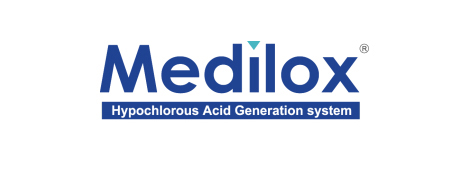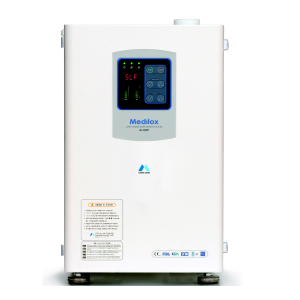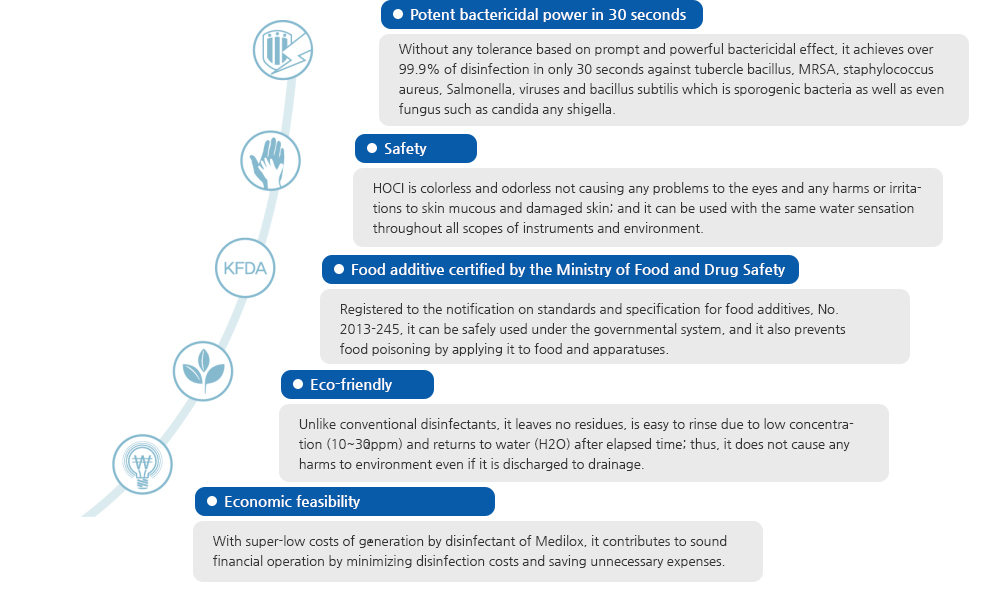 is equipment generating slightly acidic hypochlorous acid water (HOCI), an ideal non-toxic disinfectant of HACCP sterilizing 99.9%, in less than 30 seconds, of not only Salmonella, the causative organism for food poisoning, staphylococcus aureus, Vibrio parahaemolyticus, coliform bacillus (O-157), fungus and general bacteria but also various viruses such as norovirus.
is equipment generating slightly acidic hypochlorous acid water (HOCI), an ideal non-toxic disinfectant of HACCP sterilizing 99.9%, in less than 30 seconds, of not only Salmonella, the causative organism for food poisoning, staphylococcus aureus, Vibrio parahaemolyticus, coliform bacillus (O-157), fungus and general bacteria but also various viruses such as norovirus.
| Model Name | FS-5000 |
|---|---|
| pH | 5.0∼6.5 |
| Power consumption | 120Watt |
| Concentration | 10∼30ppm |
| Capacity | 600L/hr |
| Power source | 220V, 60Hz |
| Standards | 350 × 300 × 540mm |
| Additive Solution | Annexol 4L / 20L |
| Condition for water supply | Direct connection to running water, Hardness: Raw water, less than 80 ppm, pH : 6.5-7.0, Water supply pressure: 1.5-3.0㎏/㎠ |
Features of Product
Medilox Solution
| Slightly acidic hypochlorous acid water | Ozonated Water | Sodium Hypochlorite | Aqueous chlorine dioxide | |
|---|---|---|---|---|
| Active components | Hypochlorous acid (HOCI) | Ozone (O3) | Sodium Hypochlorite(Naclo) | Aqueous chlorine dioxide(CIO2) |
| Scope of certification | ||||
| - Chemical synthetics | No.426 | No.425 | No.232 | No.186 |
| - Disinfectant for instruments | 75 | 76 | 65 | |
| Bactericidal power | General bacteria/pathogenic bacteria spore-forming bacteria/norovirus Sterilization in 30 seconds (80 times stronger than bleach) | Must be used after manufactured at high concentration | Vulnerable to sporogenic bacteria and fungus | Difficulty of guarantee due to unclear component specification of processing |
| Application scope | Food: 1 ppm (ozone concentration) Apparatus: No criteria available | Food: 100ppm Equipment: 200 ppm (separated use) | Food: No notifications Equipment: 200 ppm |
|
| Safety | Low concentration chlorine content HOCl is a natural byproduct at the level of tap water generated within human body. | Standards for generation of dissolved ozone harmful to human body: Generation of 0.06 ppm of bromate, reaction to organic matters ▶causing to generate aldehyde | Corrosion due to high residual chlorine. Damages to equipment. Harmful disinfection byproducts. Irritant odor. Harmful to workers | High residual chlorine, Irritant odor, harmful disinfection byproducts. Generation of hydrocarbon/ residual chlorous acid |
| Residual features | Dissolved to revert to water after the use | No residual | Residual sterilization component (unresolved sodium) | Residual chlorous acid |
| Strengths | Quick and potent bactericidal power, non-toxic disinfectant. No odor/no decoloration | Use the liquid as it is. Safe residual features | Many uses | Low effect on pH Oxidation bleaching action |
| Weaknesses | Disinfection power decreases when reacting to organic matters | Occurrence of harmful substance. High maintenance costs. Ventilation required | Selective use. Damages to equipment. Occurrence of harmful substance | Occurrence of harmful substance Generation of chlorine gas |
| Rinse | Removal prior to completion of final food product | |||
Purpose of Use
(1) Sterilization & disinfection of food products, such as fruits and vegetables
(2) Sterilization & disinfection of fish, meat and shellfish
(3) Cleaning and disinfection of cooking utensils, including knives and chopping boards
(4) Cleaning and disinfection of floors, work benches and sinks
(5) Various instruments for food products and food services
(6) Instruments for dairy processing, food production and processing
(7) Sterilization of instruments for meal services




